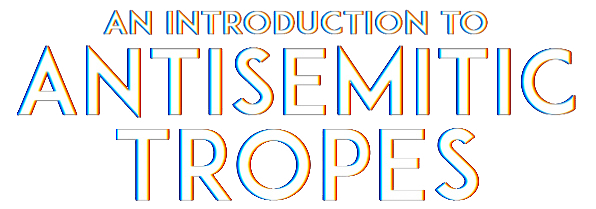
Understanding antisemitic tropes and myths is key to combating antisemitism. Unfortunately, many young people will often experience them first on social media or through popular culture instead of in a safe space, like school. We believe that if young people are educated on these tropes they will be better equipped to identify, and call out, antisemitism when they see it.
We have worked with a variety of counter antisemitism organisations across the UK to create a series of introductory videos on 7 different antisemitic tropes, as well as providing supporting and background information to each. Please use this page to view and download our videos for your use.
Important: Understanding antisemitism and antisemitic tropes is a complex task, and we do not believe our videos alone are sufficient as standalone resources. We strongly urge you to read our guidance carefully and utilise the additional resources, and if you require further information please contact us, or one of our recommended organisations.

Domination and Control
The antisemitic trope of Domination and Control remains one of the most commonly used by antisemities in contemporary society.
Today it is very often found in political discussions, in references to media, banking and political lobbying. Most imagery circulated online will depict prominent Jewish individuals and the Jewish people by extension as ‘puppeteers’, controlling world events from behind the scenes.
We highly recommend this video being used as an entry point to a discussion about this trope’s use today. Below we have recommended case studies and a glossary of terms with special relevance to the recent ‘QAnon’ terminology, as well as detailed explanations on the Protocols of Zion and how to discuss issues such as the ‘Jewish lobby’.

Holocaust Denial
In recent times, Holocaust denial content has spread onto social media platforms, giving the conspiracy theory magnified reach, which has resulted in platforms changing their policies to ban any content.
However, like many conspiracy theories, countering Holocaust denial when faced with it takes an extremely high level of factual understanding.
We have included a number of resources and case studies which provide guidance on how to spot and confront Holocaust denial, and conspiracy theories in general. We strongly urge the first resource, ‘How to Refute Holocaust Denial’ to be used alongside our introductory video to immediately provide a factual basis for countering Holocaust denial.

Blood Libel
In 2020, the QAnon conspiracy theory brought the ‘Blood Libel’ accusation back into the public sphere.
Blood libel has a long history which has been the cause for many instances frequently of mob violence and pogroms (a violent riot aimed at the massacre or expulsion of an ethnic or religious group). Recognising the repetitive similarities of blood libel accusations throughout history is key to understanding its perseverance. To address this, we have included a visual timeline to accompany the video, which expands on the images and events mentioned in the video as well as a case study of a recent painting unveiled on social media which represents one of the earliest cases of blood libel.

Dirt and Disease
The Covid-19 pandemic has exposed centuries-old tropes blaming Jews for disease spreading. These encompass a variety of antisemitic stereotypes, including that Jews are dirty, or inhuman with grotesque physical features, and that they played a deliberate role in spreading the Black Death among other global diseases for their own benefit.
Our video is an introduction to many of these tropes, but we encourage you to explore them all individually. We have included resources and case studies below to provide further context for each one.
Further Resources:
CST Report on ‘Coronavirus and the plague of antisemitism’.
Der Giftpilz - Nazi propaganda children’s book depicting ‘Jewish physical features’
Understanding the ‘Hooked Nose’ stereotype in popular culture, from Fagin to Harry Potter.
The fight to remove ‘Judensau’ sculptures from German churches

Wealth and Greed
Probably the most common antisemitic trope seen today is the accusation that Jews are either or both extremely rich and powerful, or usury and greedy. The association with money has a complex history, both factual and grossly exaggerated.
Our video touches on this history, and explores how these associations have manifested into antisemitic propaganda, as well as into popular culture.
Our resources expand on these issues, and include case studies which show the inaccuracies and consequences of the trope.

Demonisation
A common antisemitic insult is accusing Jews of Satan worshipping or associations with the devil, usually in the form of depicting Jews as demons or referring to them as ‘children of Satan’.
The historical basis for this is rooted in religious conflict, especially antisemitism in Christian-majority countries. Our video touches on these conflicts, but also explains how associations with causing the Black Death and the accusation of blood libel all played significant roles in the formation of this trope.
When exploring this concept, we strongly urge you to include discussions on the important work of interfaith dialogue today, especially following 1965’s Nostra Aetate, which is included below. It is imperative that the historical conflicts between religions are discussed, but they should not be done so in isolation, and understanding how and why interfaith dialogue has evolved over time is extremely important.

Deicide
‘Christ-killers’ is an antisemitic slur that has, throughout the ages, been used to incite violence against Jews. The accusation, that Jews caused the death of Jesus of the Christian religion, is still found on antisemitic social media content today.
The dispute on who (if anyone) should be blamed for Jesus’ death, is a complex debate among religious scholars and historians. When faced with the assertion that all Jews should be accused of deicide, individuals should be aware of the antisemitism behind the statement, but also have some understanding on the events of the crucifiction. This knowledge is vital when refuting such claims and calling out antisemitism.
We have included some resources which expand on these issues, as well as a guide on how to respond to these accusations.

Recommended Organisations

The Community Security Trust is a UK charity that protects British Jews from antisemitism and related threats.

The European Union of Jewish Students supports Jewish student unions throughout Europe, empowering Jewish youth in order to make a positive contribution to European society.

Stand Up! provides free workshops for UK students around challenging discrimination, focusing on antisemitism and anti-Muslim hatred.

The World Jewish Congress is an international organisation that represents Jewish communities and organizations in 100 countries around the world. It advocates on their behalf towards governments, parliaments, international organisations and other faiths.

The Antisemitism Policy Trust is a UK charity which focuses on educating and empowering decision makers in the UK and across the world to effectively combat antisemitism.








